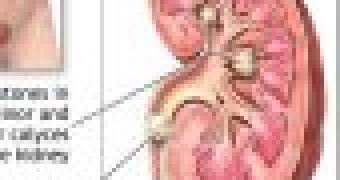About 300,000 people annually in US enter the hospitals because of the kidney stones (medically called renal lithiases). The pain is excruciating, like that felt by women when giving birth.
Some believe this condition is something recent, linked to modern lifestyle and junk food. In reality, people have been tortured by this condition for centuries. Even in the Egyptian mummies, thousands of years old, researchers found kidney stones.
The stones, named calculi, appear when minerals from the urine precipitate and increase in volume, instead of being diluted and eliminated from the body. They have various shapes and are made of various compounds. In US, 75 % of the kidney calculi are made of calcium oxalate and 5 % of pure calcium phosphate.
In North America, 10 % of men and 5 % of women will develop kidney stones along their lives and the relapse rates are high. 20 % of the patients will have a new calculus in about 5 years.
Causes for the kidney stones that have been detected so far are: metabolic impairments, infections, hereditary causes, chronic dehydration and diet. About 80 % of the renal calculi are eliminated spontaneously while pissing. To ease their elimination, patients are advised to drink large water amounts. Even if the stones can be small, hardly visible, the pain can be big. If they obstruct the urinary tract or are too big for being displaced (a calculus can reach the size of a gulf ball), medical intervention must be made.
Till 1980, the sole method was invasive surgery: a 30 cm (1 ft) incision was made on the flank to reach the calculus stuck in the kidney or urinary tract. The surgery was followed by two weeks of rehabilitation in hospital and about two months of recovery home. Newer technologies eliminated surgery, which today is required just in 1 % of the most complicated cases.
Ultrasonic lithotripsy requires just an incision of 1 cm (0.4 in) made on the flank of the body, through which a nephroscope for analyzing the inner kidney and the calculus is introduced. If the calculus is too big to be extracted with the nephroscope, inside of this apparatus an ultrasonic bore is introduced. For fragmenting the calculus, the bore is connected to a generator of ultrasounds which makes it vibrate at a frequency of 23-25 kHz. Under the power of the ultrasounds, the bore acts like a pneumatic hammer, blasting the calculi, except the hardest ones.
The little stones resulted are aspired through the bore. The fragmentation and aspiration continue till a detailed watch shows that all the calculus fragments have been removed by the bore.
Sometimes, calculus fragments refuse to move. In this case, through the nephroscope, as thin tube with small pincers is introduced. The doctor opens the pincers, grabs the calculus and extracts it.
Generally, hemorrhage is not a problem as far as this technique is concerned; still, in 4 % of the cases severe hemorrhages have been recorded. The advantages of this technology are represented by the minimal discomfort and short recovery period, just 3-6 days.
In the case of extra-corporal shock wave lithotripsy, no incision is required. The patient stays in a metallic stainless basin filled by half with warm water. He/she is positioned so that the kidney that is going to be treated is on the way of the shock waves emitted by an electric generator located in the water. The waves penetrate easily the human tissue reaching the calculus without losing power. They keep bombarding the calculus till it is crumbled. Most patients eliminate easily these fragments. 80 % of the cases of kidney stone requiring treatment may use this technique.
This technique can produce some damage in the renal area, but it does not affect the neighboring organs like spline, liver, pancreas, or intestines. This temporary trauma is well tolerated, most patients just complaining because of weak muscular and bone pains in the abdominal wall and slight traces of blood in the urine 24 to 48 hours following therapy. Even children are successfully treated this way.
To avoid the formation of the kidney stones, drink over 2 liters of water daily. Specialists also say that a decrease in red meats, salt and oxalate rich foods (chocolate, nuts, pepper and green vegetables like spinach) is recommended. In other times, it was believed that too much calcium in the diet favors the formation of the kidney calculi, but in fact abundant calcium impedes the formation of the calculi.

 14 DAY TRIAL //
14 DAY TRIAL //